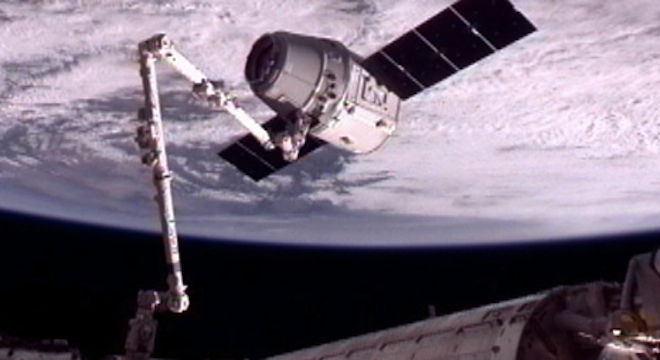History was made high above the Earth on Friday morning, when an unmanned cargo spacecraft called the SpaceX Dragon became the first-ever commercial vessel to successfully dock with the International Space Station.
“Looks like we caught a Dragon by the tail,” said NASA astronaut Don Pettit as he controlled the space station’s robotic arm, grasping the Dragon at 9:56 am ET.
Mission flight controllers at SpaceX headquarters in Hawthorne, California and at NASA’s Johnson Space Center in Houston erupted into applause and cheers as the “capture” of the Dragon by the space station robotic arm was confirmed.
“Dragon captured by the International Space Station! Just awesome,” tweeted Elon Musk, SpaceX’s CEO and lead designer, hours later.
Both the space station and the Dragon were travelling at 17,000 miles an hour some 250 miles above the Earth, just passing over Australia, when the docking procedure was completed.
Watch a video of the successful mission here:
The docking was delayed by several hours due to issues with the SpaceX Dragon’s navigational sensors, including a thermal imager and a laser guidance system, but both NASA and SpaceX were able to modify both instruments’ activities to allow the docking to get the successful go-ahead.
The docking procedure took place over the course of nearly 7 hours in various stages, with NASA giving authorization to SpaceX for the Dragon to approach the station around 2:30 a.m. E.T. Then SpaceX operators in Hawthorne remotely guided the craft near to the station, conducted tests and shut off the engines, allowing it to drift toward the station as the station’s robotic arm was extended.
Because the Dragon was not under its own power when it was grappled by the station’s robotic arm, the procedure isn’t technically a “docking,” according to NASA, but rather a “grapple” and “berthing.” “Berthing,” which refers to the actual process of attaching the two craft together, was took place at 12:02 p.m.

Screenshot of International Space Station camera’s view of the robotic arm grabbing the SpaceX Dragon capsule
On Saturday morning, if all continues to go according to plan, some of the six astronauts currently living on the space station (three Russian, two American and one European) are set to board Dragon and begin transferring 1,014 pounds of cargo onto the station.
Along with the cargo, SpaceX’s Falcon 9 rocket, which launched the Dragon into orbit on May 22, also carried the cremated remains of actor James Doohan, best known for playing Scotty on “Star Trek,” Mercury astronaut Gordon Cooper, and 306 other wealthy individuals, who paid another private company, Celestis, thousands for the posthumous journey. The remains are aboard the Falcon 9 rocket, which is itself orbiting the Earth separately, scheduled to re-enter the atmosphere in a few months and burn up.
The Dragon, by contrast, is a reusable craft that is scheduled to decouple from the space station on May 31 and re-enter Earth’s atmosphere, falling into the Pacific Ocean where SpaceX hopes to retrieve and reuse it. The Dragon has already been launched into space and successfully returned to Earth once before, in 2010.
Although Russian Soyuz vehicles travel to and from and dock with the International Space Station nearly every six months, as they have for the past decade, SpaceX’s docking mission could mark the onset of a new era of commercial spaceflight into low-earth orbit, with reusable vessels designed by private companies being used to ferry crew, astronauts and even eventually untrained civilians into space, as dependance on government space programs to get into low-earth orbit is reduced.
SpaceX has a $1.6 billion contract with NASA to conduct 12 flights to the International Space Station. About $300 million of the contract has been paid out to SpaceX so far, and this is the first of the 12 planned missions. SpaceX anticipates it will be able to ferry NASA astronauts to the station in the coming years and is testing a modified version of the Dragon for crewed flight.
Throughout the mission, SpaceX and NASA kept the public updated in micro-installments, posting frequent messages to Twitter.
On Thursday, the eve of the launch, SpaceX tweeted: “More big tests tonight for SpaceX âª#Dragonâ¬, to quote the Beastie Boys – “NO – SLEEP – TILL STATION!””






